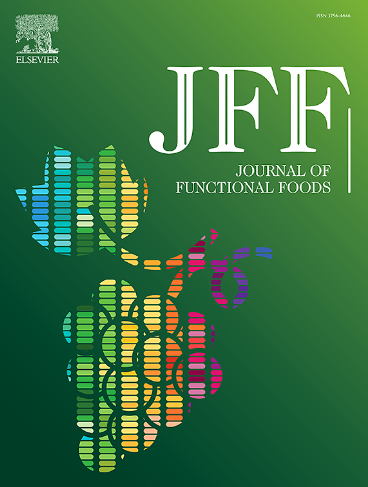基于谱效关系探讨斜叶莲子不同极性组分降血糖作用的活性成分
IF 3.8
2区 农林科学
Q2 FOOD SCIENCE & TECHNOLOGY
引用次数: 0
摘要
Inonotus obliquus(IO)是一种寄生在寒带桦树上的珍贵药用和食用真菌,因其降血糖功效而广为人知。然而,其功效的物质基础尚不清楚。本研究调查了 IO 极性馏分的降血糖潜力,并确定了主要活性成分。我们使用 UPLC-Q-TOF/MS 分析了化学成分,并评估了在 T2DM 小鼠模型中的效果。IO 处理组降低了 FBG、OGTT-AUC、GSP、INS、HOMA-IR、TC、TG、LDL-c、ALT 和 AST 水平,并增加了 HDL-c。IO-J 部分对 T2DM 小鼠具有相对突出的效果和肝脏保护作用。谱效关系分析表明,有七种化合物与低血糖相关:该研究建立了 IO 部分的谱效关系,为探索 IO 作为降血糖药用真菌和食用真菌的潜力提供了理论基础。本文章由计算机程序翻译,如有差异,请以英文原文为准。

Exploring the active components of hypoglycemic effect in different polar fractions of Inonotus obliquus based on spectrum-effect relationship
Inonotus obliquus (IO) is a kind of precious medicinal and edible fungi parasitized on birch trees in the cold zone, is widely recognized for its hypoglycemic properties. However, the material basis of its efficacy is unclear. This study investigated the hypoglycemic potential of polar fractions from IO and identified key active components. Using UPLC-Q-TOF/MS, we analyzed chemical compositions and evaluated the effects in a T2DM mouse model. IO-treated groups reduced FBG, OGTT-AUC, GSP, INS, HOMA-IR, TC, TG, LDL-c, ALT, and AST levels, and increased HDL-c. The IO-J fraction demonstrated a relatively prominent effect and liver protection in T2DM mice. Spectrum-effect relationship analysis revealed seven compounds correlated with hypoglycemia: Osmundacetone, Inonotusol A, Inonotusol C, Inonotusol F, Protocatechuic acid, Inonotusane F, and Inonotusone A. This research establishes the spectrum-effect relationship of IO fractions and provides a theoretical foundation for exploring the potential of IO as a hypoglycemic medicinal and edible fungi.
求助全文
通过发布文献求助,成功后即可免费获取论文全文。
去求助
来源期刊

Journal of Functional Foods
FOOD SCIENCE & TECHNOLOGY-
CiteScore
9.60
自引率
1.80%
发文量
428
审稿时长
76 days
期刊介绍:
Journal of Functional Foods continues with the same aims and scope, editorial team, submission system and rigorous peer review. We give authors the possibility to publish their top-quality papers in a well-established leading journal in the food and nutrition fields. The Journal will keep its rigorous criteria to screen high impact research addressing relevant scientific topics and performed by sound methodologies.
The Journal of Functional Foods aims to bring together the results of fundamental and applied research into healthy foods and biologically active food ingredients.
The Journal is centered in the specific area at the boundaries among food technology, nutrition and health welcoming papers having a good interdisciplinary approach. The Journal will cover the fields of plant bioactives; dietary fibre, probiotics; functional lipids; bioactive peptides; vitamins, minerals and botanicals and other dietary supplements. Nutritional and technological aspects related to the development of functional foods and beverages are of core interest to the journal. Experimental works dealing with food digestion, bioavailability of food bioactives and on the mechanisms by which foods and their components are able to modulate physiological parameters connected with disease prevention are of particular interest as well as those dealing with personalized nutrition and nutritional needs in pathological subjects.
 求助内容:
求助内容: 应助结果提醒方式:
应助结果提醒方式:


